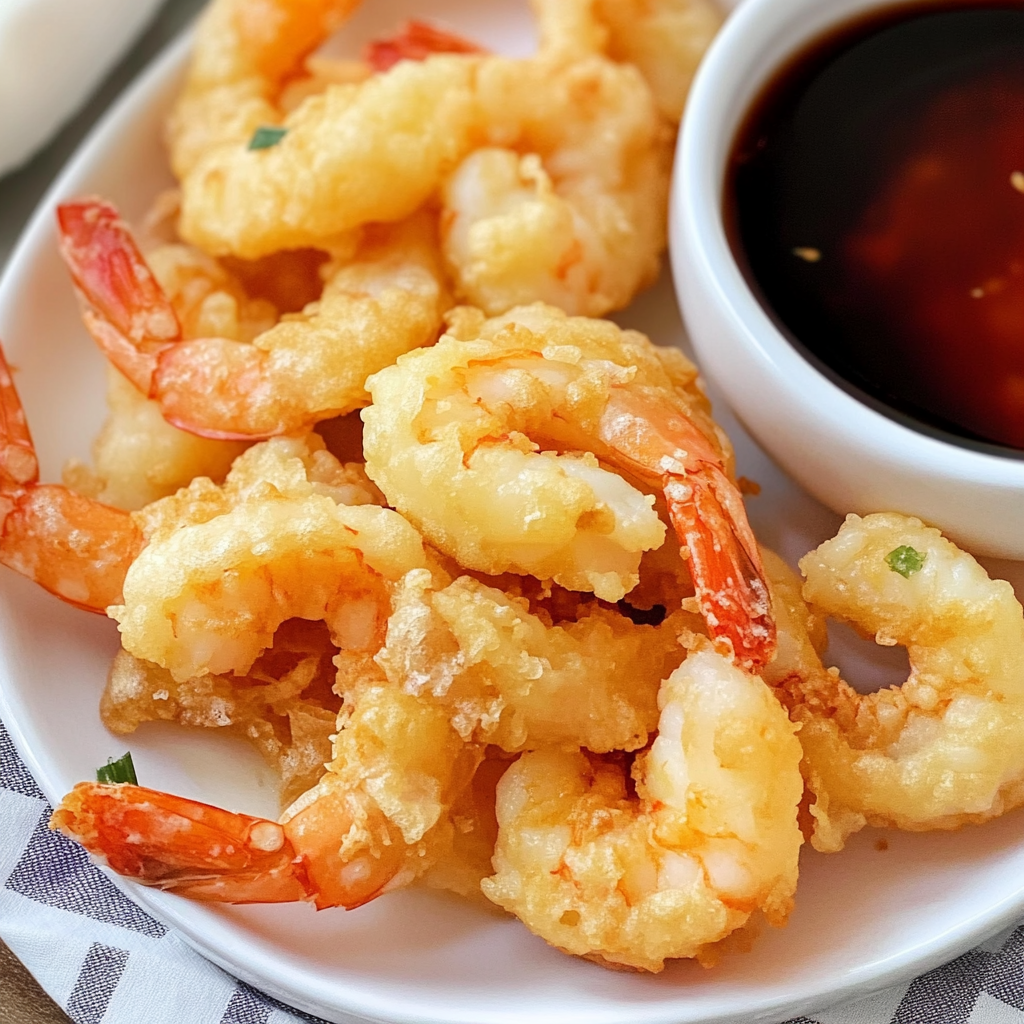Shrimp tempura is a classic Japanese dish known for its light and crispy batter that perfectly complements the tender, juicy shrimp inside. The magic lies in the cold, lumpy batter combined with high-temperature oil frying, creating a satisfying crunch without greasiness.
This dish is versatile and elegant enough for dinner parties but simple enough for a quick weekday meal. Serve it with a traditional soy-based dipping sauce or get creative with spicy mayo or ponzu. The contrast between the golden crisp tempura and succulent shrimp makes it a crowd-pleaser that always feels special.
Full Recipe
Ingredients:
-
1/2 lb large shrimp, peeled and deveined (tails on)
-
1 cup all-purpose flour
-
1/2 cup cornstarch
-
1 teaspoon baking powder
-
1/2 teaspoon salt
-
1 cup ice-cold sparkling water (or ice water)
-
1 egg yolk
-
Vegetable oil, for frying
-
Optional: tempura dipping sauce (soy sauce, mirin, dashi, and grated ginger)
Directions:
-
Rinse the shrimp under cold water and pat dry thoroughly with paper towels. Leave tails on for presentation if desired.
-
In a large bowl, whisk together the flour, cornstarch, baking powder, and salt.
-
In a separate bowl, lightly beat the egg yolk. Add the ice-cold sparkling water and mix gently.
-
Pour the wet ingredients into the dry ingredients and stir lightly just until combined. The batter should be lumpy and cold; do not overmix.
-
Heat vegetable oil in a deep fryer or a large heavy-bottomed pot to 350°F (175°C).
-
Dip each shrimp into the batter, letting excess drip off, then carefully place into the hot oil.
-
Fry the shrimp in batches for about 2-3 minutes or until the batter is crisp and golden.
-
Remove shrimp with a slotted spoon and drain on paper towels.
-
Serve immediately with tempura dipping sauce or your favorite condiment.
Prep Time: 15 minutes | Cooking Time: 15 minutes | Total Time: 30 minutes
Kcal: Approximately 250 kcal per serving | Servings: 4 servings
Shrimp Tempura: A Crispy Japanese Delight You Can Master at Home
When it comes to Japanese cuisine, few dishes manage to strike the delicate balance between simplicity and sophistication quite like Shrimp Tempura. Characterized by its golden, crisp batter and juicy, tender shrimp interior, tempura has become a favorite not just in Japan but globally. The recipe featured on Crunchy Creamy Sweet captures the essence of authentic tempura while making it accessible for home cooks.
The Origins and Cultural Significance of Tempura
Tempura’s story dates back to the 16th century, introduced to Japan by Portuguese missionaries and traders. The technique of batter frying was adapted and perfected by Japanese cooks, ultimately evolving into the iconic dish known today. Shrimp, being a delicacy and widely enjoyed seafood, became the perfect ingredient to showcase the light, airy tempura coating.
Today, tempura is a staple in Japanese households and restaurants. It is enjoyed as an appetizer, part of a bento box, or as a topping for udon and soba noodle dishes. The versatility and textural delight of tempura make it one of the most beloved Japanese preparations.
Why Shrimp Tempura Appeals to the Western Palate
One of the reasons Shrimp Tempura has found a home in Western kitchens is its familiar texture and flavor profile. While some Japanese dishes may require an acquired taste, tempura uses common ingredients shrimp, flour, eggs and relies on a method (deep-frying) that is already popular worldwide. The recipe from Crunchy Creamy Sweet presents a version that aligns well with Western cooking styles, offering easy-to-follow steps and tips for achieving restaurant-quality results.
The Science of Perfect Tempura: Why Technique Matters
What makes tempura stand apart from other fried foods is its uniquely light and crisp texture. Achieving this requires attention to several key techniques, many of which are expertly explained on the Crunchy Creamy Sweet blog:
-
Cold Batter is Crucial: One of the most important factors is using icy-cold water and eggs when mixing the batter. This slows gluten formation, preventing the batter from becoming dense or doughy. The cold batter hitting hot oil also contributes to that signature lacy, crisp coating.
-
Minimal Mixing: Overmixing the batter will activate gluten in the flour, which toughens the final crust. A few lumps are okay in fact, they are desirable. This prevents the coating from becoming bread-like, allowing it to fry up light and crisp.
-
Cornstarch for Cling: Coating shrimp in cornstarch before dipping them in batter helps the wet batter adhere more evenly. This step also helps to seal in moisture, keeping the shrimp juicy while ensuring the batter stays crisp.
-
Strategic Oil Temperature: Temperature control is essential. Frying at 340–360°F ensures the batter crisps up quickly without soaking up excess oil. Frying in small batches (3–4 shrimp at a time) prevents the oil from cooling down too much, which would result in soggy tempura.
-
Straightening the Shrimp: In restaurant presentations, shrimp tempura often appears elongated and flat. This isn’t accidental. Making 4–5 shallow slits on the shrimp’s belly prevents it from curling during cooking, producing a sleek and elegant appearance.
Flavor Beyond the Fry: Sauces and Accompaniments
While shrimp tempura is delightful on its own, it becomes elevated when served with the right dipping sauce. Traditionally, tempura is paired with tentsuyu sauce, a blend of dashi (a type of Japanese soup stock), mirin (sweet rice wine), soy sauce, and grated daikon radish. This slightly sweet, umami-rich condiment complements the delicate flavor of the shrimp and balances the oiliness of the fried batter.
For those adapting the recipe to ingredients more commonly found in Western kitchens, Crunchy Creamy Sweet recommends serving it with soy sauce, sweet chili orange sauce, or even a tangy sweet-and-sour sauce. These options provide an approachable way to enjoy the dish without needing specialty items like dashi or mirin.
Common Pitfalls and How to Avoid Them
If you’ve ever tried making tempura at home and ended up with soggy, limp shrimp, you’re not alone. The most common issues include:
-
Oil too cool: The batter absorbs oil instead of crisping quickly.
-
Letting the batter sit too long: Over time, gluten forms and ruins the lightness of the batter.
-
Overcrowding the pot: This causes a drop in temperature and uneven frying.
The blog wisely advises making the batter just before frying and cooking the shrimp in small batches to avoid these issues.
Pairing Shrimp Tempura with Other Dishes
Shrimp Tempura is highly versatile. It can be part of a multi-course meal, served alongside miso soup, a cucumber seaweed salad, or Japanese pickles. It also works beautifully when added to:
-
Tempura Udon or Soba: Hot or cold noodle dishes topped with shrimp tempura.
-
Sushi Rolls: As the crunchy component in tempura rolls.
-
Rice Bowls: Known as “tendon,” where tempura is served over steamed rice with a drizzle of sauce.
Even Western-style presentations like serving it as an appetizer with a sweet chili dipping sauce are perfectly acceptable and widely enjoyed.
The Joy of Making Tempura at Home
As intimidating as deep-frying may seem, Shrimp Tempura is surprisingly simple when done correctly. The blog post demystifies the process and encourages experimentation. Once you’ve mastered shrimp, it’s easy to extend the technique to vegetables like sweet potatoes, bell peppers, green beans, or mushrooms.
This flexibility also makes tempura a fun family meal or party appetizer. It invites creativity try different dips, explore new ingredient combinations, or serve it in unique ways.
Conclusion:
The Shrimp Tempura recipe from Crunchy Creamy Sweet does an excellent job of simplifying a dish that might otherwise seem complex. By breaking down essential techniques and offering practical tips, it empowers home cooks to replicate a restaurant-quality dish in their own kitchens.
Shrimp Tempura embodies everything people love about Japanese food: balance, texture, subtlety, and visual appeal. Whether you’re preparing it as a quick appetizer or the centerpiece of a larger meal, this dish offers both culinary satisfaction and cultural exploration.
Making tempura isn’t just about cooking it’s about engaging with a time-honored tradition and delighting in the sensory experience it delivers: the sizzle of shrimp in hot oil, the crackle of the crispy coating, and the savory dip of soy-based sauce. With a little preparation and attention to detail, anyone can master this Japanese classic and add a touch of elegance to their home-cooked meals.






